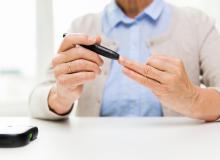If blood sugar is measured too frequently or in the wrong way, not only will your fingers suffer, but expensive test strips will be wasted. So, what is the point of measuring blood sugar?
The ring finger, the preferred site for measuring blood sugar
In fact, there is no difference in blood sugar measured on the left and right hands or five fingers. However, in relative situations, clinicians often recommend that patients choose the ring finger, middle finger, and little finger, because these fingers have less activity on weekdays and have a low probability of infection. The pain is mild and does not affect daily life, but the thumb and index finger, which are the most flexible, sensitive and used most, should be avoided.
But when it comes to the best choice, the ring finger is still the first choice. In addition to the advantages mentioned before, another important reason is that the capillaries in our palms have two branches, one of which is at the end of the ring finger. Therefore, compared to other fingers, the ring finger occupies an important blood hub and has richer blood.
Learn the correct way to test finger blood
Some patients are used to collecting blood by pricking and squeezing, and the results of measuring blood sugar always show normal, until some complications occur. After going to the hospital for examination, they find that their blood sugar is much higher than usual. This situation often occurs because the patient massages excessively and squeezes the needle site too hard during the blood collection process, because this will squeeze out part of the tissue fluid and dilute the blood sample, causing the blood sugar test results to be low.
The correct approach is: before blood collection, you can hang your arm for 10 to 15 seconds to make the fingertips engorged with blood. After the needle is inserted, gently push the blood vessels on both sides of the finger to the front third of the finger, allowing the blood to slowly overflow from the wound. A "small drop of blood" appears from the site. It is recommended that patients gently wipe away the first drop of blood after blood collection with a cotton swab, because the first drop of blood often contains more tissue fluid, which may also affect the results.
Diabetics want to keep blood in their fingertips full without causing blood sugar deviation. You can do some preparations before measuring blood sugar:
① Massage the part of the finger that is to be acupunctured from the root of the finger to the fingertip 5 to 6 times to make it warm and congested. You can also droop your arm so that it is lower than the level of the heart for better congestion.
② Swing your arm like a thermometer to fill your fingertips with blood.
③Tie the middle knuckle of the finger to be measured with a rubber band to allow blood flow to the fingertip. After tying, loosen the rubber band to allow blood flow.
Things to note when taking a finger blood test
1. If the finger for blood collection is damaged, infected, scarred or has a rash, do not choose this finger for the time being. At this time, the finger needs to be disinfected with alcohol. Therefore, it is best to carefully check whether the above problems occur on the finger before blood collection.
2. If diabetic patients use the same finger to collect blood for a long time, the finger skin will be dehydrated, dry, rough, and calluses will form, causing inconvenience in future blood collection. Therefore, before taking blood from your finger, you can wash your finger with warm soapy water, because warm water can also promote blood circulation and make your finger more congested. Regardless of the cleaning method, you must wait until the skin is dry before collecting blood to avoid affecting the accuracy of the results.
3. After blood collection, use hand cream or ointment for diabetic hand and foot protection to keep your fingers moisturized to reduce the formation of calluses.
4. Once your fingers become red, swollen, hot and painful, be alert to the possibility of infection. Antibiotic ointment can be applied and bandaged. If there is no relief after simple treatment, please seek medical treatment in time.

